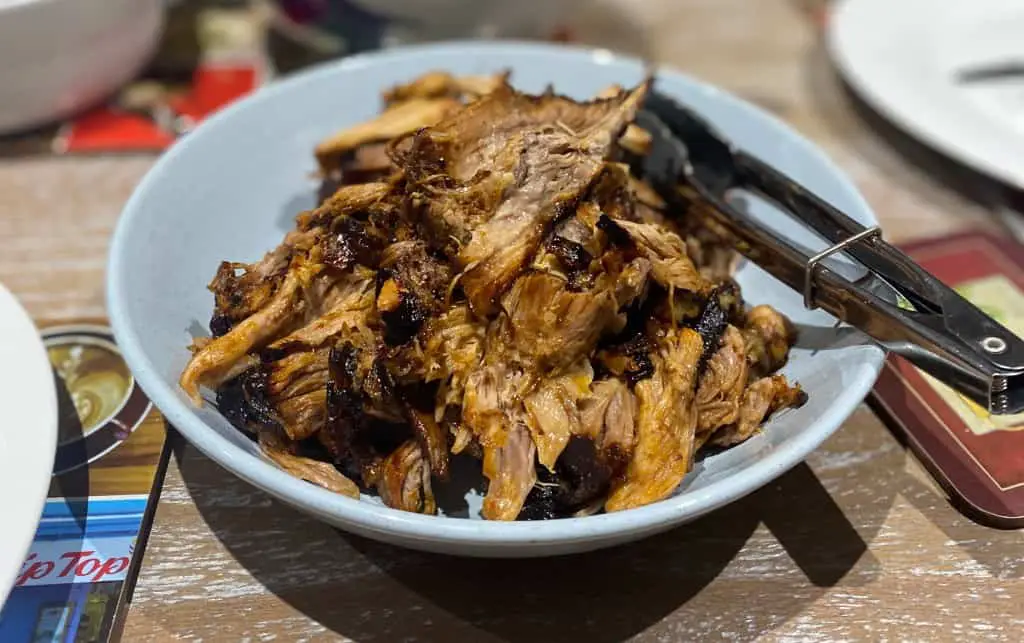Pork butt, or Boston butt, is one of the most popular meats to smoke, and one of my favourites.
The glory you feel during the smoking process and the succulent deliciousness of the pork makes for the ultimate barbecue experience.
If you’re new you might be wondering what the best wood for smoking pork butt is, or if you’re experienced you may be looking for a new flavor combination to try out for your next smoking session.
Although it does mostly come down to personal preference, there are some clear wood flavors that just work better.
Which Wood Is Best For Smoking Pork Butt Or Shoulder?
Hickory Wood
Flavor Profile:
Smokiness: Strong & Traditional
Flavors: Bacony & Well-Rounded
Hickory Wood For Smoking Pork Shoulder
- Hickory has the power to deliver the traditional barbecue smokiness we all love over all other woods. Because pork butt is a large chunk of meat and takes on flavor well, hickory helps the smokiness really stand out.
- Because pork butt pairs well with sweeter or fruitier flavors you can blend your favorite sweet or fruity wood with hickory at a 50:50 ratio for a perfect combination of both smokiness and sweet or fruitiness.
- As hickory doesn’t contribute sweet, nutty, or fruitier flavors it’s very versatile. Therefore hickory will pair nicely no matter what rub or sauce you use, whether it’s a spicy barbecue rub or even a salty, sweet rub.
- Hickory can leave an overwhelming smokiness on the meat if smoked at high temperatures or for very long periods of time, but generally, this doesn’t become an issue for pork butt.
Hickory is a fail-safe option to deliver an incredible smoke to your pork butt. Believe me, even when your pull your pork every bite has that smokiness we are all far too addicted to!
Because of its versatility and strength in smoke, you can’t go wrong. If you do like a bit of sweetness or fruitiness with your smoked pork like I do you can blend hickory wood by adding equal parts of apple or cherry too for an amazing combination.
If you really want to go the extra mile, you can cut your pork shoulder in half to maximize the bark-to-meat ratio, and allow the meat to absorb more smoke.
Apple Wood
Flavor Profile:
Smokiness: Mild
Flavors: Sweet & Subtle Fruitiness
Apple Wood For Smoking Pork Shoulder
- Apple is a classic smoking wood, and pork butt takes on the sweet and subtle fruitiness very well.
- If you use apple wood for smoking pork butt by itself you will have a mild smokiness with a sweeter note to it.
- If you love the unique flavor of smoking apple wood but like a bit more oomph you can blend apple wood with stronger smoking woods such as hickory or oak for a well-balanced profile.
- It’s certainly up to personal preference whether to blend it or not though. Apple wood by itself is still phenomenal!
- It’s hard for the smokiness of apple wood to overpower any meat so long as you smoke it at normal, 225-275°F.
Overall apple wood is definitely one of the favorites in the barbeque world for sweet and fruity flavors. Apple wood smokes very cleanly and easily, but because of this, it’s best to always keep it in control, and ensure the smoking temperatures stay around 225-275°F.
Still, the overall smokiness is quite mellow, so if you prefer the strong traditional barbecue smoke, try blending it with oak or hickory, or even a small amount of mesquite!
Cherry Wood
Flavor Profile:
Smokiness: Medium
Flavors: Uniquely Sweet & Fruity
Cherry Wood For Smoking Pork Shoulder
- Cherry wood is a dream pairing for smoking pork butt. Not only does it burn hot and provide a good amount of smoke, but it also has a distinct fruity smokiness to it too.
- Cherry is also quite sweet, so it works even better when paired with a hot and spicy rub and sauce to even it out.
- Again, it doesn’t provide the oomph of hickory, oak, or mesquite, but it’s still a top pick for smoking pork butt, either by itself or by blending it.
Cherry is a great alternative wood flavor for smoking pork butt, and if you haven’t used it before it’s a must-try.
It really enriches the pork and balances out the flavors, particularly if you’re pairing it with a spicy rub (which I usually do). The saltiness of the pork, the spiciness of the rub, the acidity of the sauce, and the smoky-sweetness of the cherry wood. Fan-tas-tic.
Maple Wood
Flavor Profile:
Smokiness: Medium
Flavors: Sweet with a Subtle Smoke
Maple Wood For Smoking Pork Shoulder
- Maple is the go-to for those who don’t require the power of hickory or mesquite, but still want a solid smokiness without the fruitiness of cherry, peach, or apple.
- Maple blends very well with a stronger smoking wood, particularly with hickory.
- You can’t go wrong with maple, it burns easily and consistently and I’ve never experienced any over-smoking or unwanted bitter tastes. It’s a safe choice for pork butt with a more subtle smokiness.
Maple is certaintly a common choice for smoking pork butt. It’s easy, it gets the job done, and it’s consistent. Maple is the perfect choice between the sweetness of a fruit wood like apple or cherry, and the strong smokiness of hickory, oak, or mesquite.
Pecan Wood
Flavor Profile:
Smokiness: Mild
Flavors: Distinctly Nutty!
Pecan Wood For Smoking Pork Shoulder
- Pecan is most famously smoked for its true and distinct nuttiness.
- Certainly a different profile than your classic hickory or apple, but one that is subtle, but flavorsome.
- My recommendation: always keep some pecan handy for when you want to mix it up a bit.
- If you want to tone down any strong smoking wood, like mesquite or hickory, pecan wood is a perfect choice, bringing something new to the table entirely.
- If you want some more sweetness, mix pecan wood with your favorite fruit wood like apple or cherry. Really, the world is your oyster here.
We couldn’t put together the best wood for smoking pork butt or shoulder without mentioning one of the greatest nutty-flavored woods out there.
Although not everyone’s first choice, if you haven’t tried pecan smoked pulled pork you’re missing out. The perfect combination of smokiness and nuttiness really helps balance out the salty savouriness of the pork, and the classic sweetness of any barbecue sauce.
Blending Woods For Smoking Pork Butt Or Shoulder
Blending woods give you even more control over the flavor. Again, it’s always more important to nail the other aspects of the smoking process before focusing on wood, but once you’re experienced it’s always enjoyable to try the combinations that from mixing smoking wood.
- As a rule of thumb, hickory can be blended with most other woods. It works particularly well when blended with apple, cherry, peach, or other fruit woods.
- These fruit woods also pair well with smokier woods such as oak or hickory.
- Blending fruit woods together can work fine, but the main reason you would blend woods is to find a more balanced and even flavor.
There are countless different woods to blend, and you really can get creative, if there is an uncommon must-try flavor combination please let me know i would happily try it out.
Logs, Chunks, Chips, Or Pellets?
Generally speaking, the less processed the wood is, the truer the wood flavor will be.
However, whether you’re using an offset smoker with logs, a charcoal grill with wood chunks or wood chips, or a pellet grill with wood pellets, the smokiness of the wood should still come out nicely.
So, whichever wood you’re using, the best flavors for pork butt or pork shoulder still remain.
Hickory for a strong oomph of smokiness, apple for a subtle sweetness, or cherry for a good mix of the two. If you want something different try maple or pecan.
Most woods work nicely, but these are the most popular for a reason!
Easy Smoked Pork Butt Recipe

This recipe can be followed whether you’ve got a pork picnic shoulder or pork butt, and whether the meat is from the finest butcher or it’s a Costco pork shoulder!
Rub:
Start by applying a binder to the outside of the meat, usually, a light coating of yellow mustard works well or ketchup is fine too. Generously apply your favorite rub (whether it’s spicy, savory, or sweet) evenly on all its sides.
And I really mean GENEROUS! When you pull your pork you want to taste the rub no matter what piece you’re grabbing!
Smoke:
Whatever smoker you’re using, always allow it to come up to temperature before adding any wood. Around 250-275°F tends to work best for pork butt.
5 minutes before putting the pork butt on the smoker, add your favorite wood for smoking, in whichever form you smoker takes!
Control your temperature and smoke – utilize your vents! Hold the temperature around 275°F.
Spritz:
After two hours, start using a spray bottle every hour to spritz the meat in order to keep it moist, help create the bark, and add complexity to the flavor. You can choose to mix water with either red wine, or vinegar, just to add that moisture to it.
Cover:
After 3-4 hours, and repeating the spritzing process every hour, your pork butt should be a nice dark mahogany brown all over with edges of blackened bark. Once you’re happy with it, remove the pork butt, insert your thermometer probe, give it one last spritz, then immediately wrap it up in 3-4 layers of foil to lock in that moisture.
Return to the smoker until the internal temperature comes up to 195-200°F.
Glaze & Pull
Finally, unravel all the foil and apply your favorite barbecue glaze. This could be your own recipe of barbecue sauce or store-bought, or a concoction of spice, sweetness, and traditional barbecue flavors.
To finish off the pork butt and to develop the bark even further put the pork butt back on the smoker for an additional 10-15 minutes.
Once you’re satisfied, take it off, let it cool for 15 minutes to an hour and pull it apart!
Enjoy.








